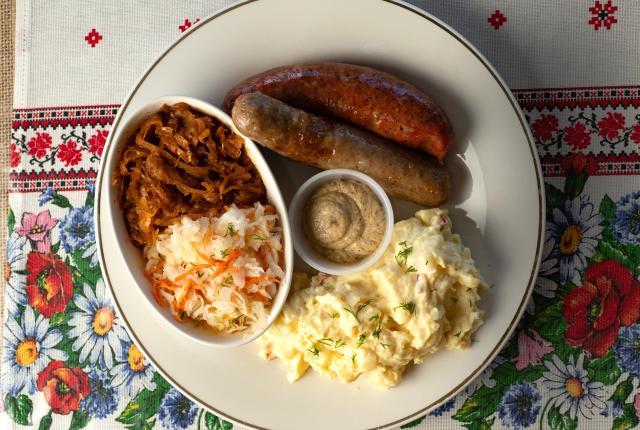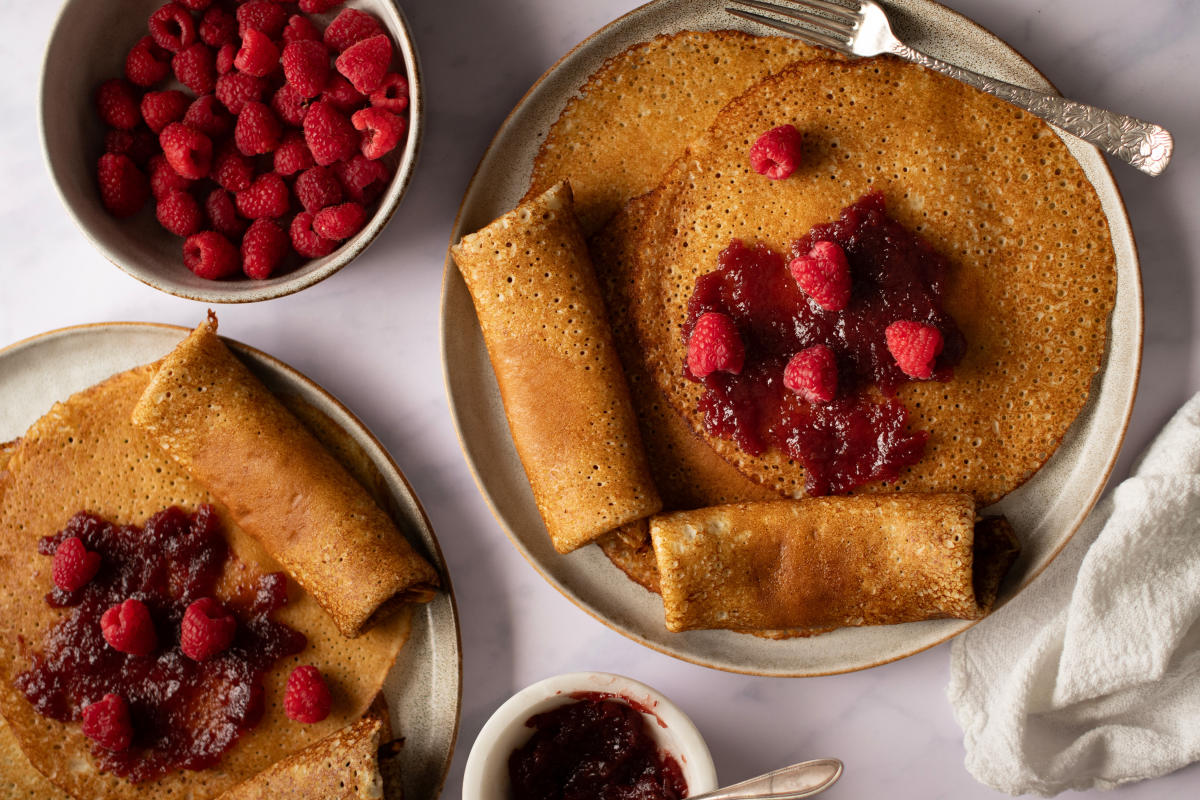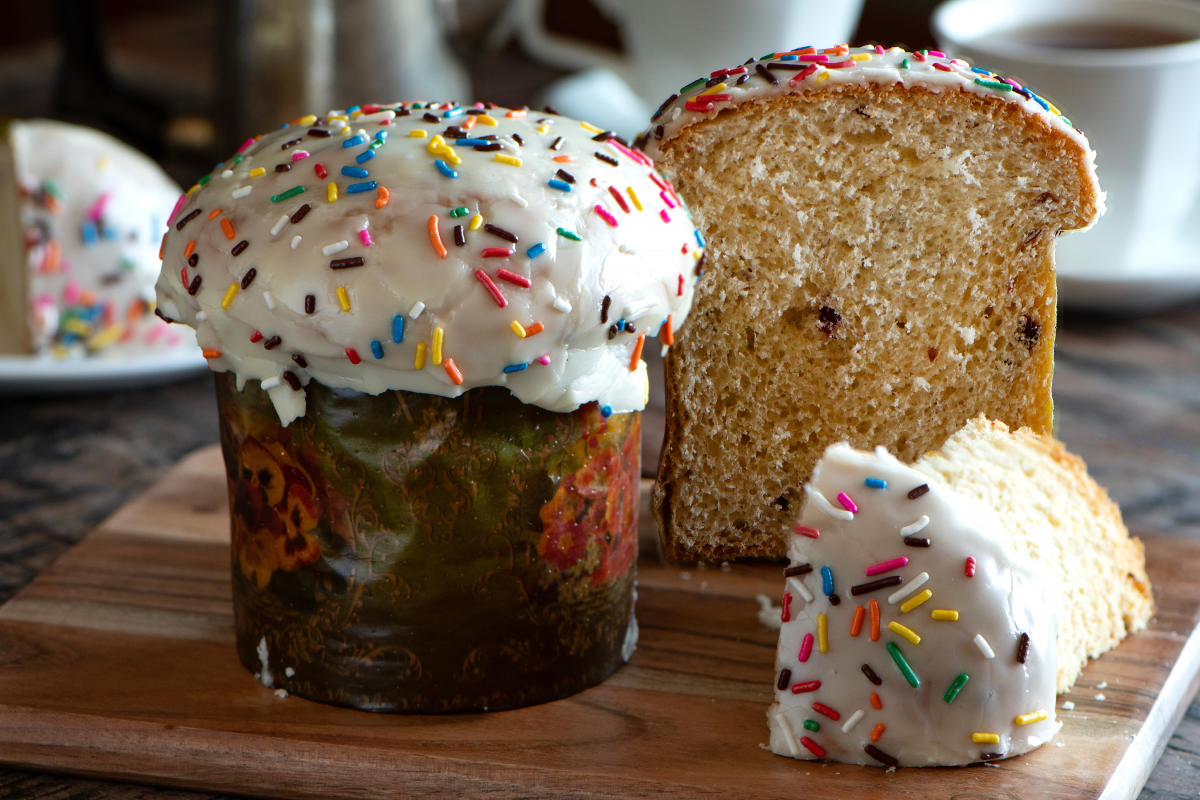WHILE NEW MEXICANS LOVE their inimitable regional cuisine, they also crave dishes from around the world, with or without the addition of green chile.
As the largest city in the state, Albuquerque is home to a sizable and incredibly diverse population of foreign-born and second-generation restaurateurs who prepare specialties from Southeast Asia to West Africa to Central America—and most places in between. When it comes to European cuisine, we tend to be most familiar with, and have greater access to, foods originating from the western or southern regions of the continent—Italy, France, Spain, Greece. However, the Albuquerque area is fortunate to have an assortment of vibrant Central and Eastern European cuisines to savor as well.
At the foothills of the Sandía Mountains lies a German micro-bakery with macro appeal. Near Uptown, a busy deli takes its time to carefully prepare delicacies from Poland and Ukraine. And, in Rio Rancho, a local institution carries on a proud legacy of serving a German immigrant’s world-class strudel and schnitzel.
Red Rock Deli sits in an unassuming strip mall off San Mateo Boulevard, but step through its heavy glass door and patrons are transported to a world bursting with bright flavors. The specialty grocery store stocks hard-to-find imported items, such as pickled herring, packaged kutia (wheat-berry pudding), and Bulgarian cheeses. Its kitchen offers traditional dishes like smoky Polish sausage with tangy house-made sauerkraut, tender pork-stuffed cabbage, and a hearty Ukrainian borscht.
“True Ukrainian borscht has beans,” says chef and co-owner Alissa Toczek. In addition to navy beans, her rendition of the brothy beet soup has tender morsels of potato, carrot, and red cabbage, and is served with a crusty roll and a side of sour cream. “Borscht ingredients and techniques vary from region to region, like pizzas do,” she notes.
Born in Soviet Ukraine, Toczek imagined that a life in the United States would mean glitz, glamor, and Hollywood. That is, until she arrived in 2011 and an astrologer informed her that her true calling was feeding people—much to her chagrin, initially. Not one to challenge fate, Toczek began experimenting in the kitchen, conducting culinary research here and abroad, and taking cooking classes online, which she still does regularly. “Me and [celebrity chef] Gordon Ramsay are Scorpios, and those people don’t look for easy ways,” she says. “We do the work.”
All of it has paid off. Toczek joined her equally driven Polish husband, Mark Toczek, in opening his second deli (the first is in Blanca, Colorado) in Albuquerque in 2014. In 2021, Hollywood came calling for the Toczeks after all, when Red Rock Deli was featured on Guy Fieri’s Food Network show Diners, Drive-Ins and Dives.
The chef says the appearance was “destiny” since one of Fieri’s cookbooks was among the first she purchased on her culinary journey. The timing of Fieri’s visit was also fortuitous. The pandemic had brought lean times, Toczek says, but after the episode aired in January 2022, the deli became so popular that they expanded in 2023.
Burqueños clamor for the deli’s plump pierogi (available in 11 filling combinations, including vegan options), perfectly fried pork schnitzel, and the beloved Italian beef sandwich. “I don’t believe in limiting your borders,” Alissa explains of the presence of Chicago’s iconic sandwich, as well as hamburgers, on Red Rock’s menu.
However, the most rewarding aspect of the deli for the Toczeks comes from sharing their native dishes with the local community, especially with those who are far from home. “This food brings up a lot of memories for people,” she says. “Everyone is so appreciative of what we do. They bring us Christmas presents, write ‘Please don’t close’ on their receipts. It’s moments like that that make us think, Maybe we are doing something for a lot of people.”
Two other local businesses catering to the international community are Dagmar’s Specialties, in Rio Rancho, and the Albuquerque micro-bakery Das Brotkoerbchen (meaning “the bread basket”). Both focus on German delicacies, and it may come as a surprise that New Mexico’s German population is the third-largest immigrant group in the state, comprising 2.4 percent of the total number of foreign-born residents—a number that’s double the national average. “I’d guess 95 percent of our customers are [of German ancestry],” says Dagmar’s general manager and chef, Anthony, who declined to give a surname. “They come from all over the state—Española, Carlsbad, Taos.”
Although the bakery/grocery store/restaurant has seen several iterations and locations since the late Dagmar Schulze Mondragon started it in the mid-1990s, its current rendition has proved especially popular with those seeking traditional German fare. “Dagmar made such a big mark on the German community here,” says her close friend Michael Almanzar, who bought the business after the beloved cook’s passing in February 2023. “Being from Germany myself, I knew we couldn’t close it. So I stepped in for her and her customers. It’s been rewarding.”
Upon entering the cozy specialty shop, customers are greeted by a large glass case filled with an assortment of German chocolate and cheesecakes, delicately layered puff pastries, and Dagmar’s signature fruit and cheese strudels topped with glistening pearl sugar crystals. The restaurant offers to-go breakfast and lunch options, such as Dagmar’s Authentic Jägerschnitzel (breaded pork loin topped with mushroom gravy and a side of homemade spaetzle), house-made bratwursts, and Hungarian goulash. (Earlier this year, renovations were underway to create a dine-in space as well.)
Keeping Schulze Mondragon’s legacy alive means making her golden strudels, brötchen (rolls), schnitzels, and Black Forest cake just the way she did. “Dagmar was a typical German. When she taught me her recipes, she would not let me write anything down,” says Anthony, who runs the kitchen. “They are all in my head, and I promised her I would teach people the same way. Why change something that works?”
For a more modern take on German baked goods, I signed up for Das Brotkoerbchen’s bread client list. The Albuquerque bakery’s owner Barbara Leiber-Klotz learned to bake from watching her mother in their small village in southwest Germany, but she says it was never her passion. “It wasn’t until I moved to the States and discovered I hated the bread here that I started making my own,” she says.
Her main quibble with American breads is the prevalence of industrial processed ingredients and the amount of sugar many bakeries use. Leiber-Klotz also didn’t like the way her body felt after consuming them. “Real bread should be simple,” she says, “good flour, water, salt, leaven, maybe some fresh yeast. But never additives like preservatives or emulsifiers.”
Leiber-Klotz has found that most Americans only know the “1950s version” of German baked goods, but there has been considerable evolution over the years. In particular, she prefers to make rustic breads and pastries that incorporate ancient grains. Flours made from heirloom grains such as einkorn, emmer, spelt, kamut, and quinoa are thought to be more nutritious and digestible, and they may have more-complex flavor profiles.
But the most important ingredient she uses is time. “Big bakeries don’t have the time to ferment their dough overnight,” she says. “It tastes fresher, holds better, and allows gluten to break down outside, not inside your body.”
During the pandemic, the hobby baker, like many other people, turned to her sourdough starter to keep busy. She began churning out a variety of fresh brötchens and German, Austrian, Swiss, and South Tyrolean breads and gifting them to her neighbors. Word of Leiber-Klotz’s delicious and crusty breads soon got out, and she found herself inundated with orders from friends and strangers. “It snowballed,” she laughs.
Three years later, Das Brotkoerbchen is a full-fledged cottage business that still operates out of Leiber-Klotz’s immaculate home kitchen with designated order and pickup days. Her bread clients receive a weekly text with each day’s menu options—soft German lye pretzels on Wednesdays, breads and a sweet pastry on Thursdays, and a variety of breakfast rolls every Sunday. That said, Leiber-Klotz doesn’t want her little bakery to get much bigger.
“It’s not about the money,” she says. “I do this because it’s fun; I get to meet new people and educate them. I want everyone to bake—and I think Americans can do better.”
“Growing up, I would be sent to the village bakery around the corner every Saturday morning to get a variety of fresh brötchen,” says Barbara Leiber-Klotz. “Germans love their daily fresh bread rolls, especially on weekends for family breakfast.” Note: The bakers prefer grams as a unit of measurement because weight is more accurate than volume. The included conversion measurements to cups are approximate.
- 400 grams (1 ¾ cups) lukewarm water
- 8 grams (2 teaspoons) sugar
- 6 grams (2 teaspoons) fresh yeast or
- 2 grams (½ teaspoon) dry yeast
- 500 grams (3 ¾ cups) quality bread flour*
- 13 grams (2 ½ teaspoons) sea salt
- Sesame, pumpkin, or sunflower seeds (optional)
Optional: Substitute 10 to 40 percent of the bread flour with another, such as sprouted spelt, whole wheat, medium or dark rye, einkorn, emmer, or kamut. Use more water with this option but add gradually.
Makes 8 to 10 broetchen
DAY BEFORE BAKING
- In a large bowl, mix about 50 grams (4 tablespoons) of lukewarm water with sugar and yeast. Let sit until foamy, about 5 to 10 minutes. Then add the rest of the water.
- Add flour(s) and salt. Mix well with a whisk and cover the bowl with a wet towel.
- Let dough rest at room temperature for about 2 to 3 hours, incorporating 3 to 4 “stretch and folds” every half hour. This will strengthen your dough and develop its gluten. For this, lightly wet your fingertips, grab a portion of the dough, and stretch it upward. Fold the dough over toward the center of the bowl. Rotate the bowl a quarter turn, repeat, and continue folding and turning until you have completed a full circle.
- Cover the bowl tightly with plastic wrap and refrigerate overnight.
BAKING DAY
- Set oven to 500° and place a shallow oven-safe bowl on the bottom of your oven and heat some water in a tea kettle.
- Take the dough out of the refrigerator. Carefully let it slide out of the bowl and onto a well-floured surface, then cut into 8 to 10 pieces with a dough cutter. You can do squares, rectangles, triangles, etc.
- Place dough pieces onto a baking sheet lined with parchment paper. Let sit and rise for about half an hour. If you wish, you can top with seeds.
- Place baking tray in oven (second level from bottom), pour some hot water into the shallow bowl, and close the oven door immediately. Bake for 10 minutes, then briefly open oven door to let steam out. Bake for another 10 minutes or until golden brown.
Celebrated at the end of the winter, a week before Great Lent, Maslyana (or Maslenitsa) is perhaps the oldest surviving Slavic holiday. According to Alissa Toczek, its main holiday dish, the mlyntsi (a hot, thin pancake) is said to symbolize the sun. “By eating a lot of pancakes, people invite the sun into their lives and welcome spring.”
- 3 eggs, room temperature
- Pinch of salt
- 75 grams (6 tablespoons) sugar
- 3 cups milk, room temperature
- 240 grams (2 cups) all-purpose flour
- 60 grams (about ¼ cup) sunflower oil
Makes 10–12 blini
- Beat eggs with salt and sugar until foamy.
- Add 1 cup milk and stir thoroughly.
- Add flour and whisk together until smooth with no lumps.
- Add the rest of the milk; stir.
- Add oil and whisk again. Allow the mixture to rest covered at room temperature for 15 to 30 minutes before cooking.
- Spray nonstick frying pan with oil and set over medium heat.
- Using a ladle, pour the batter (about ¼ to ½ cup, depending on pan size) onto the frying pan and swirl it around in a circle to cover the bottom. (If the batter is too thick and hard to cover the pan, add more milk to the batter. If it is too thin and falls apart when flipping, slowly add more flour.)
- Watch the temperature and adjust heat between medium and low, as needed. Cook for about 45 seconds to 1 minute, or until the blini is mostly set and the bottom is golden brown. Flip and cook another 20 to 30 seconds or until browned.
- Before each new pancake, stir the batter with a ladle so the flour does not settle at the bottom of the bowl.
- Serve with sweet or savory accompaniments such as jam, honey, sour cream, gravlax, or caviar.
Paska (or kulich) is a traditional Ukrainian sweet bread/cake served at Easter. “The tall cylindrical cake is similar to artos (leavened bread blessed at Eastern Orthodox and Byzantine Catholic churches), Toczek says. “Traditionally, it is baked on Maundy (Holy Thursday).”
- 135 grams (about ½ cup) milk
- 10 grams (3/4 tablespoon) dry yeast (or 50 grams fresh yeast)
- 180 grams (almost 1 cup) sugar, divided
- 550 grams (4 ½ cups) all-purpose flour, divided
- 2 eggs
- 40 grams (3 tablespoons) sunflower oil
- 50 grams (¼ cup) sour cream
- 100 grams (½ cup) cream cheese
- 70 grams (about 1/3 cup) unsalted butter
- 2 grams (1/3 teaspoon) salt
- 9 grams (2 teaspoons) vanilla sugar
- 1 cup dried fruits, plus more for garnish
GLAZE
- 1 to 2 oranges, juiced
- Powdered sugar
- Sprinkles, optional
- Special equipment: 5 baking molds, approximately 5 by 4 inches. You can use spring pans; silicone or panettone paper molds; or parchment-paper-lined coffee cans (baking times vary depending on the size of your molds)
Note: All ingredients should be room temperature and all dry ingredients should be sifted.
Makes 5 servings
FOR THE STARTER:
- In a tall bowl, mix milk, yeast, 1 tablespoon sugar, and 3 tablespoons flour. Cover the bowl with plastic wrap and leave in a warm place for 10 to 15 minutes until foamy.
FOR THE DOUGH:
- Whisk eggs with the rest of the sugar in a stand mixer bowl until a voluminous, lush mass forms.
- Change out whisk attachment for bread hook; add the rest of the ingredients, except the flour and dried fruits. Mix well.
- Add the starter and mix on low speed, gradually adding the rest of the flour.
- Once all flour has been added, mix on medium speed until the dough stops sticking to the bowl. You can also knead the dough by hand.
- Cover the bowl with a towel and let it proof 1 to 2 hours, no longer. The mixture should have doubled in size.
- Preheat oven to 320°.
- Mix dried fruits into the dough.
- Layer the bottom and sides of your baking molds with parchment paper.
- Divide the dough into portions, about 290 grams each. Each portion should not exceed one-half of the height of your mold.
- Place the molds in a warm spot and let them proof until dough reaches the top of the molds.
- Bake 30 to 35 minutes. The breads should be golden brown and the inside temperature should be 203° to 205°. If the tops are getting too dark before they are ready, cover tops with foil, shiny side down, and bake until done.
- Take paskas out of the oven and let sit for 5 to 10 minutes. Then remove from the molds so they don’t get soggy.
FOR THE GLAZE:
- In a bowl, mix juice and powdered sugar until desired thickness (the thicker the consistency, the whiter the glaze will be).
- Dip the tops of cooled paskas into the glaze. Decorate with sprinkles or dried fruits.









